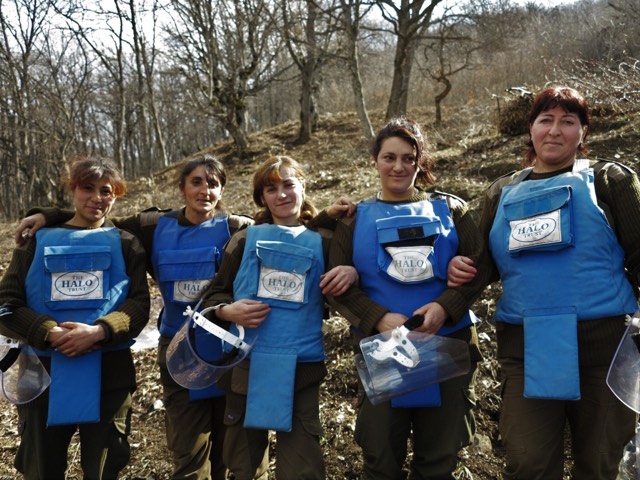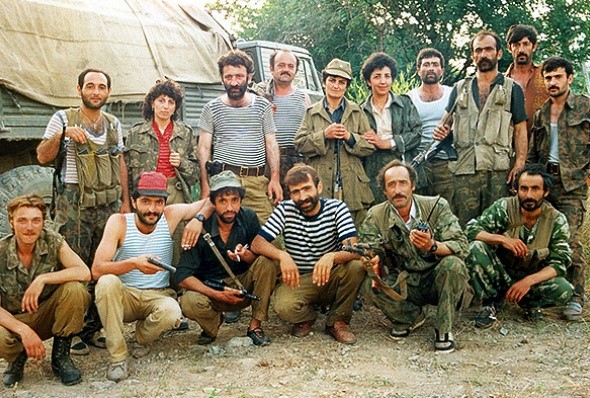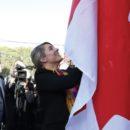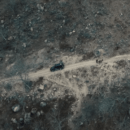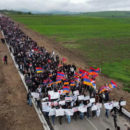Artsakh Supreme Court of Justice is composed of all female judges headed by Narine Narimanyan (third from the left). (Photo by Karl Mancini from his long term work ‘Women of Artsakh). http://www.karlmancini.com/women-of-artsakh)
By: Karin Saghdejian Deragopian
In October 1993, when I was in Artsakh as a young reporter for the Armenian daily Aztag, Artsakhtsi mothers, who had either lost a son or a husband, their eyes pleading for intimacy and support, led me to their houses. I remember vividly how the main rooms looked: there on one corner, dedicated to the martyr, a huge photo frame hung on the wall surrounded by military outfits and memorabilia of the fallen soldier. After a brief chat of emotionally loaded moments of empathy, unusual hospitality ensued; the grieving women, covering their pain for a moment, suddenly turned into generous hosts. Despite the ongoing war and the scarce resources, fruits, nuts, and homemade sweets appeared on the table with coffee and local tea to welcome the guest- hayi aghjig as they used to call me. At that time foreigners rarely visited Artsakh, and when locals saw one, they would guess they were either a diasporan Armenian (spyurkahye) or a foreign journalist-as sometimes foreign correspondents or aid workers ventured into Stepanakert.
That year Karabakh forces had made big advances on all fronts taking over cities like Agdam, Fizuli (Varanda), Jabrail (Jrakan) and Zangilan (Kashatagh), but counterattacks were still claiming lives. You could feel the all-out war reality prevailing on every level. Everyday women would rush to the military hospital in Stepanakert to check if their sons’ or husbands’ names appeared on the list of killed soldiers pinned up on the outside wall.
Since those days of my first encounter with the Artsakh women, I was deeply moved by their ability to carry an unfathomable pain and keep an attitude of normalcy and resolve.
This attitude was not confined to a few. Thousands of women put personal grief aside and carried on, sustaining the family and uplifting fighting sons and husbands and till today continue to do so.
The story of the women of Artsakh has not been properly told so far. We know little about the countless women who through their everyday acts of survival, shoulder much of the burden of the war and maintain the fabric of society. Their daily big and small sacrifices make them the unsung heroes of the Artsakh war that need to be studied and spotlighted.
Our popular and even historic understanding of the Nagorno Karabakh war (1988-1994) is through the lens of the men who fought and won the war against all odds, at times through ultimate sacrifice. We know the names, the details of their selfless acts; we have exalted them in our patriotic songs, history books and in our national lore. We rarely speak about the countless women who were entrusted to keep the Artsakh home in order when men were absent. What about the keepers of the hearth (ojakheh var bahoghnereh) who had to tend to the house, feed the children and keep panic at bay? We don’t know their names and faces and we don’t tell their stories.
From Housewives to Warriors and Breadwinners
When the Karabakh movement started in 1988, The Autonomous Region of Nagorno Karabakh population was living in traditional Armenian family structures, despite the “emancipation” of the Soviet woman that the communist ideology had preached for seven decades. The reawakening of the national identity and unification with the motherland further heightened the need for traditional Armenian family values and patriotism.
With the outbreak of fighting, nearly all Karabakhi men of adult age took up arms, and responsibilities for providing for the family fell on women. Shaped by tradition and social practice, women took on the task of tending to the household and, within a few months, became the main breadwinners of the now “headless” family.
The transformation of the Artsakh women from the traditional housewives who primarily tended to the needs of the family into heads of the household responsible for its economic and social functioning happened abruptly.
Social anthropologists Nona Shahnazarian and Ulrike Ziemer have done significant work in exploring the wartime gender identity changes the Karabakh society underwent. They point out that in the wartime family structure shifted to bolster the idea of brotherhood in support of the nation. They say Karabakh Armenians became coherently tied to each other. Families accepted and sometimes merged with each other out of patriotic solidarity. And in the absence of the male figure women stood out as the sole caregivers of the family.{1}
Women assumed many roles both in the actual war and within the household. At least 100 women fought in the war, 17 of them killed and 16 disabled. Women fought beside men (like Anahid Martirosyan who became a commander), others worked in medical supply teams. The presence of women on the front boosted the morale of the fighters as Shahnazarian and Ziemer point out, though the motivation to take arms was usually a personal choice, men felt being with a woman on the battlefield gave them more impetus to fight. Though quantitatively not significant, “women war experiences equal to those of men, in fact, demythologized the sole male function of the nation’s “defender”. {2}
But the more important role of women was on the domestic front. Their resourcefulness and self-sacrifice kept the families together and economically sustained in times when shortages of food and goods were commonplace.
Shahnazarian and Ziemer explore the issue of how during the war Artsakh returned to big family traditions as families moved in together as a survival strategy and for the sake of the communal good. Many women preferred to live with in-laws who helped with childrearing and sustenance. Others during and after the war, when men were absent, resorted to petty trading as an alternative way of providing for the family.
Women underwent a tremendous amount of hardship but did it with conviction. “War has so hardened us, women,” says Julietta Arustamyan, the widow of a fallen officer and now head of the Harmony non-governmental organization, which organizes cultural events for women, in an interview with The Institute for War & Peace Reporting journalists. “We lived through so much that if someone told us to sit on a tractor and fly to Mars, we could do it.” {3}
Post War Reality of Survival and Transformation

Policewomen in the country’s capital of Stepanakert. (Photo by Karl Mancini from his long term work ‘Women of Artsakh). http://www.karlmancini.com/women-of-artsakh) {6}
When the ceasefire came into effect in May 1994 after 6 long years of fighting, the majority of Artsakh women were either widowed or had lost a son or a brother in the battlefield. This, combined with home responsibilities had taken their toll. Women had to both tend to their wounds and continue to support the family when many men were gone and those that were back had no jobs.
No support or aid agency was on the ground to provide psychological help or counsel. Instead, women once again resorted to their inner strength to carry on. When you ask an Artsakhtsi woman about her emotional wellbeing, a common response would be “we can’t do much about it as we have all been through similar hardships”.
As Marine told me during a recent interview: “I never talk to anyone about my emotional issues. I keep it to myself.” A jovial grandmother who had three young children when her husband went missing in the southern front in 1993. “Why burden others when we all have the same pain.”
A poignant way of coping with the collective pain and transmitting the memory was the creation of the Museum of the Fallen Soldiers in the heart of Stepanakert, where over 3555 photos hang in a small cavernous gallery that amplifies the immense loss. Mothers and wives, shortly after the ceasefire, started organizing and putting together photos and relics of their men, which later formed the basis of today’s museum. One woman, Galya Arustamyan, who lost her 21-year-old son in battle, stood out as the driving force who helped collect the pictures and memorabilia from the soldiers’ families and then managed the museum for many years till her death in 2014.
War left behind a large number of widows. War widows hold a nearly sanctified place in Artsakh society and the state rewards them and their children with pensions and accolades.
The majority of war widows refused to remarry after the war, either fearing the loss of a special social standing they hold or just sacrificing their personal needs before community ideals. Shahnazarian and Ziemer, in their study on Artsakh widows, say war widows in Nagorno Karabakh represent a powerful symbol of patriotism and remarrying would have led to their marginalization. Widowhood demanded further sacrifice and many widows were ready to take the mantle as it meant keeping their husbands’ memory alive in their children. Both researchers conclude that the many sacrifices Karabakh women have made can be regarded as stories of resourcefulness and not as signs of submissiveness or powerlessness. {4}
In the post-war period, Artsakh women have increasingly become visible in political and social spheres. Working as a businesswoman in Karabakh is a common practice nowadays. According to official data, out of the National Assembly’s 33 deputies, 5 are women; there is a female minister among the 12 ministers (Minister of Education, Science and Sports Narine Aghabalyan) of the Artsakh cabinet. All the judges of the NK Supreme Court are women, headed by Narine Narimanyan.
The workforce in some ministries and sectors like health, social services, and education is 80% women; in finance and culture, it’s 60%. It’s remarkable how many Artsakh women are involved in the private business sector- around 43% of sole proprietors are women. A visible number of women are also employed in the police force and in the demining teams of Nagorno Karabakh branch of the Halo Trust, the world’s largest humanitarian mine clearance organization.
And of course, there are still many other women who choose to stay at home to have more time with their families.
This apparent post-war elevated status of Artsakh women shows their adaptability- how they have been able to resourcefully combine the norms of traditional patriarchal society and personal freedom and needs.
Keepers of Hearth: Collective Heroism
The resumption of fighting is an ever-present danger in NK. The four-day war in April 2016 has exacerbated that danger and has revealed the elusiveness of peace. It has also proven that women will continue losing sons, brothers and husbands and a stable future is still a distant goal.
Despite their assumed mission of raising sons to become soldiers and even martyrs, ask any woman in Artsakh about her aspirations and the answer unequivocally would be: peace. After all, Artsakh women know too well that the prerequisite for safeguarding the land and perseverance amid all odds is a stable household. When soldiers get killed or fighting breaks out, they are the ones to keep panic and confusion at bay and stand their ground. Many women I talked to during my recent visit either had a son in the army or one about to join. Their matter-of-fact attitude tinged with worry but ultimately unyielding in spirit is nothing but heroic.
The role of women being the guardians of the hearth (ojakh, synonymous to home) is deeply rooted in the Armenian national identity shaped throughout centuries. An Armenian mother is above all the keeper of the hearth (ojakheh var bahogheh)- a term that often comes up whenever you have a conversation with Karabakh women about the reasons for their resiliency.
Nelly Ghulyan, the wife of the famed military leader Ashot Ghulyan (Pegor) who was killed in 1992, told me recently that during the Artsakh Liberation War her husband had made it clear that whatever happens she must not take the kids and leave the village. “I rarely saw Ashot.He was on the battlefields all the time. When he was home, he instructed me; listen, you never leave the village. ojakhi dzookheh bedk e varvats mna, (The smoke of the hearth fire should keep on rising). She said he believed that if villagers saw them staying, they would be encouraged to stay and not evacuate the village.
Scholar Sevan Beukian, in her research entitled “Motherhood as Armenianness: Expressions of Femininity in the Making of Armenian National Identity” says the hardships that women undertook during and after the war were expressions of an Armenian historical perception of motherhood. “Women see themselves and are constructed as the mothers in the Armenian nation-building process and as the transmitters of culture and the guardians of memories.” This characteristic is derived from the ordeals the Armenian people have gone through in history. {5}
NK women continue this path of sacrifice for the purpose of the collective values in their everyday existence. Their acts of heroism are not confined to a few names or incidents. What they consistently show us is an ongoing act of collective heroism in line with the historic roles Armenian women have played during times of physical threats such as the Genocide or existential threats like the fear of assimilation in the diaspora. A collective heroism whose heroes are every single Artsakh woman holding up the sky for the nation to persevere and prosper at this difficult juncture of history.
——————————————————–
Karin Saghdejian Deragopian is the Editor-in-Chief of “TorontoHye” Newspaper. She is currently researching the changing gender roles of women in Artsakh.
*The names Artsakh and Nagorno Karabakh are used interchangeably.
References:
{1}, {2} -Shahnazarian, Nona & Ziemer, Ulrike. Emotions, Loss and Change: Armenian Women and Post-socialist Transformations in Nagorny Karabakh. Caucasus Survey, Volume 2, 2014 – Issue 1
{3} – Ohanyan Karine, Danielyan Anahit. “Karabakh War Changed Women’s Roles for Ever”, The Institute for War & Peace Reporting. Global Voices, Caucasus, December 20, 2010.
{4} -Shahnazarian, Nona and Ziemer, Ulrike (2018). Women Confronting Death: War Widows’ Experiences in the South Caucasus. Journal of International Women’s Studies, 19(2), 29-43.
{5} -Beukian, Sevan. Motherhood as Armenianness: Expressions of Femininity in the Making of Armenian National Identity, Studies in Ethnicity and Nationalism. (2014). Volume 14, Issue 2, pages 247-269.
{6} -Karl Mancini, “Women of Artsakh, Dreaming Independence and Peace”). http://www.karlmancini.com/women-of-artsakh).


